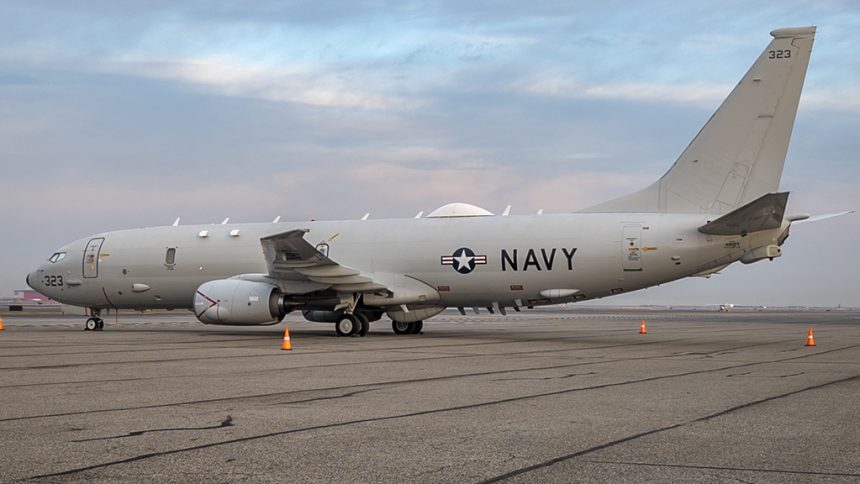A P-8A Poseidon of the secretive VPU-2 squadron has been modified with the addition, among all other things, of the MUOS UHF-band SATCOM dome.
On Dec. 12, 2023, our reader Jeffrey Stoermer, spotted a pretty interesting U.S. Navy P-8A Poseidon parked on the South-East ramp of Salt Lake City Int’l. The aircraft was in an open viewing area, so Jeff could snap the shot of the Poseidon that you can find in this article.
The aircraft in question is one of the so-called “mystery” Poseidons operated by Special Projects Unit (VPU) 2 Wizards out of NAS Jacksonville, Florida. The unit is known for conducting signals intelligence (SIGINT), electronic intelligence (ELINT) and other types of secretive reconnaissance missions with a fleet of at least 5 specially modified P-8A whose peculiarity is the presence of a wide array of antennas and sensors not carried by the baseline maritime patrol aircraft, as well as the fake registration.
For instance, the one in question, sports the (fake) BuNo 169323, although the latter is not allocated. Its real BuNo is 169338. This airframe has been upgraded in a configuration previously seen on at least another “mystery” Poseidon, the (fake) serial BuNo 168384, which was first spotted in 2022 with a retractable FLIR turret on the lower side of the forward fuselage as well as an interesting hump on the rear upper fuselage.
The latter is the dome of the MUOS (Mobile User Objective System) receiver.
New Lockheed Martin “Mobile User Objective System” (MUOS) UHF-band satcom hump spotted on the rear dorsal spine of 🇺🇸 US Navy P-8A Poseidon 167954, one that has had a history of shadowing E-6B Mercury TACAMOs in tests. https://t.co/Q2Epw21qCP pic.twitter.com/u65P65KLPM
— Evergreen Intel (@vcdgf555) May 28, 2022
In a 2016 document, the U.S. military described MUOS as follows:
MUOS is the DOD’s next-generation narrowband military SATCOM system, replacing the UHF Follow-On (UFO) constellation that is reaching end of life. MUOS is a satellite-based communications network designed to provide worldwide, narrowband, beyond line-of-sight, point-to-point (P2P), and netted communication services to multi-Service organizations of fixed and mobile terminal users. MUOS is designed to provide 10 times the throughput capacity of current narrowband SATCOM. The Navy designed MUOS to provide increased levels of system availability over the current constellation of UFO satellites, as well as improved availability for small, disadvantaged terminals that is typical for a current mobile user over UFO.
MUOS is the equivalent to a global cellular service provider that converts 3G wideband code division multiple access (WCDMA) cellular phone system to UHF SATCOM to provide modern cell phone-like capabilities like simultaneous crystal-clear voice, and video and mission data on a high-speed Internet Protocol-based system, to warfighters.
Integration of the system onto the P-8 fleet was investigated in 2020, to determine the feasibility of installing MUOS capability on dual SATCOM channels on the P-8A while maintaining the rest of the communication interfaces.
As we have already explained in various articles here at The Aviationist, U.S. Navy P-8As are much more than “just” MPA (Maritime Patrol Aircraft). The Poseidons are in fact multi-mission platforms that can gather valuable intelligence using a wide array of sensors. Among these, an Advanced Airborne Sensor (a dual-sided AESA radar that can offer 360-degree scanning on targets on land or coastal areas, and which has potential applications as a jamming or even cyberwarfare platform according to Northrop Grumman); an APY-10 multi-mode synthetic aperture radar; an MX-20 electro-optical/infrared turret for shorter-range search; and an ALQ-240 Electronic Support Measure (ESM) suite, able to geo-locate and track enemy radar emitters.
In that respect, the P-8A Poseidon represents a huge leap forward if compared to the P-3 Orion. For instance, the externally mounted AP/ANY-10 MTI imaging radar system (upgrade from the P-3’s Littoral Surveillance Radar System – LSRS), adds both an overland and maritime MTI capability approaching the fidelity provided by the US Joint Surveillance and Target Attack Radar System (JSTARS). The significant difference with the more modern P-3s is, in particular, in the P-8’s ability to rapidly exchange and share information internally among the crew and externally among joint partners.
All the Poseidon’s sensors contribute to a single fused tactical situation display, which is then shared over both military standard and internet protocol data links, allowing for seamless delivery of information amongst U.S. and coalition forces. Hence the need for a robust communication system like MUOS to allow the precious asset to stay connected everywhere and in all conditions.









